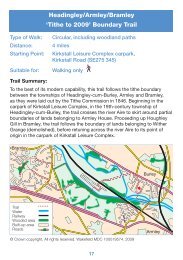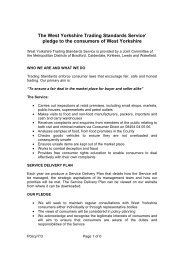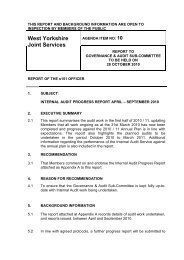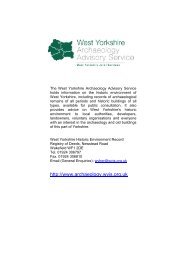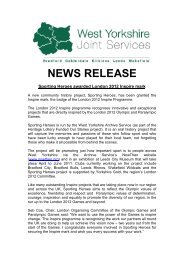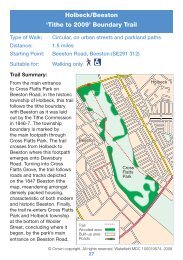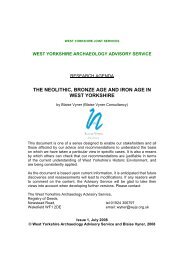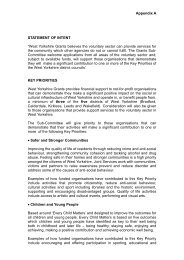Collections Guide - West Yorkshire Joint Services
Collections Guide - West Yorkshire Joint Services
Collections Guide - West Yorkshire Joint Services
Create successful ePaper yourself
Turn your PDF publications into a flip-book with our unique Google optimized e-Paper software.
War Hospitals(WYL1205) 1917–1918 Leeds, Killingbeck Hospital, photographs of patients and staffKillingbeck Hospital was previously known as Killingbeck Municipal Sanatorium and during the First WorldWar the isolation wards were used for soldiers. The hospital was built in 1913 on the Killingbeck Hall estateand had been purchased by the city council in 1898 from Mrs Meynell Ingram of Temple Newsam. The hallwas demolished in 1978. These photographs were given to WYAS by a lady whose father, Mr F Taylor was apatient at the hospital, recovering from his war wounds.Home Front(WYL2144) 8 September 1915 Leeds City Police, ‘European War, amended PoliceInstructions in the event of air raid’(LMT/MO/TCC/199/1) 1951–1960 ‘Bi-Bq’ Morley Borough miscellaneous file includingcorrespondence with various individuals and companies on a variety of subjectsincluding limbless veterans of the First World War(WYL793) 1859-1968 <strong>West</strong> Riding of <strong>Yorkshire</strong> Rifle Volunteer Corps records(WYL1701) 1922-1999 Leeds Wounded Warriors Welfare Committee records (supportof returning wounded soldiers and families)(WYL230/acc4080/27) 1915–1916 Women Workers, labour shortage and request forwomen workers during the First World WarDuring the First World War, many women were able to participate on the home front supporting the men whohad gone to fight. They were given the opportunity to help as nurses, teachers, textiles makers, coal minersand clothing, but the largest area in which the women worked was in the munitions factories. Munitionsfactories were there to produce supplies for the men on the front including tailoring, metal trades, chemicaland explosives, food trades, hosiery and woolen and worsted industries. The reason for so many womenjoining the munitions factories and other parts of the war effort was mixed between the sense of patriotismfelt for working and helping their fathers, brothers and husbands fighting, or because the wages receivedwere double what they had previously made (although it was still less than that of a man’s). Nursing becamealmost the only area of female contribution that involved being at the front and experiencing the War. InBritain the Queen Alexandra's Royal Army Nursing Corps, First Aid Nursing Yeomanry and Voluntary AidDetachment were all started before the First World War. The VADs were not allowed in the front line until1915 (further information can be found at: http://en.wikipedia.org/wiki/Women's_roles_in_the_World_Wars,accessed 24/04/13).



